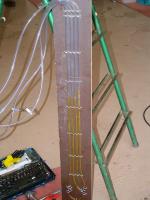Hi all,
There is a very long story behind this post, but, in the interests of not boring everyone, after 4 and 1/2 years, it was time to get the 2006 FJR on the road again......
First issue is after siphoning out the old gas and putting in new, the old beauty started up after a few minutes (a battery recharge etc was needed). After the initial reluctance the bike starts effortlessly now. Had it up to operating temperature etc. now it seems the old hos' really hesitates when starting off, increase the RPM and let the clutch slip and she takes off fine, clearly though there is something off. Any suggestions where to start ? Kms (Canada) are 24,000 nothing in terms of maintenance had been done before she was put away for rest outside of fluids changed and a rear tire. When on the road she seems happy to purr along at anything above 3000 RPM I can't detect any issues. Comments ?
Second issue is more of a mystery to me, Before going out on the road I noticed there was no rear brake when the pedal was applied. Changed all the fluids, bled etc and got the pedal back. There was no fluid in the rear master cylinder when I investigated. Now, the brake pedal is great but I suspect there was brake fluid somehow got onto the pads and rear disc. I did the brake fluid flush over two weeks ago and there is no visible sign of a fluid leak anywhere. Being left unused and outside in Canada over three winters I wondered if the seals leaked and then after me redoing the brakes they "rehydrated" and have sealed up the rear piston. As I say, no visible leaks for two weeks and I have used the brakes extensively. Anyway, the two questions related to this - anyone experienced/seen anything like this ? What do you recommend - rebuild rear caliper, change pads (somehow they got the leaked fluid on/into them). Any finally - how to ensure there is no residual brake fluid on the rear disc once I change the pads, I don't want to contaminate them.
Any feedback on either topic is very welcome.
There is a very long story behind this post, but, in the interests of not boring everyone, after 4 and 1/2 years, it was time to get the 2006 FJR on the road again......
First issue is after siphoning out the old gas and putting in new, the old beauty started up after a few minutes (a battery recharge etc was needed). After the initial reluctance the bike starts effortlessly now. Had it up to operating temperature etc. now it seems the old hos' really hesitates when starting off, increase the RPM and let the clutch slip and she takes off fine, clearly though there is something off. Any suggestions where to start ? Kms (Canada) are 24,000 nothing in terms of maintenance had been done before she was put away for rest outside of fluids changed and a rear tire. When on the road she seems happy to purr along at anything above 3000 RPM I can't detect any issues. Comments ?
Second issue is more of a mystery to me, Before going out on the road I noticed there was no rear brake when the pedal was applied. Changed all the fluids, bled etc and got the pedal back. There was no fluid in the rear master cylinder when I investigated. Now, the brake pedal is great but I suspect there was brake fluid somehow got onto the pads and rear disc. I did the brake fluid flush over two weeks ago and there is no visible sign of a fluid leak anywhere. Being left unused and outside in Canada over three winters I wondered if the seals leaked and then after me redoing the brakes they "rehydrated" and have sealed up the rear piston. As I say, no visible leaks for two weeks and I have used the brakes extensively. Anyway, the two questions related to this - anyone experienced/seen anything like this ? What do you recommend - rebuild rear caliper, change pads (somehow they got the leaked fluid on/into them). Any finally - how to ensure there is no residual brake fluid on the rear disc once I change the pads, I don't want to contaminate them.
Any feedback on either topic is very welcome.

























![fjackets Real Lambskin Leather Biker Jacket — Quilted Cafe Racer Zip Up Moto Leather Jackets For Men | [1100085] Johnson Brown, XL](https://m.media-amazon.com/images/I/41I7Pm1f+vL._SL500_.jpg)





































